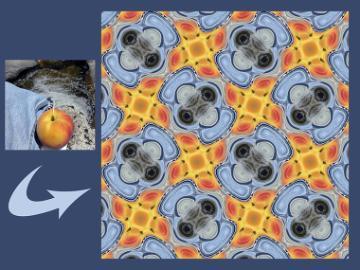
Creating Symmetry: A Tale of Complex Math and Inventive Wallpaper
After editing Mathematics Magazine for many years, Frank Farris realized it was time to plan what his next big project might be. “I wasn't so interested in problems and puzzles,” he recalls, “but in the stories that bring us face to face with the grand structures of mathematics.”
Since then, Farris has been following his storytelling instincts. The associate professor of mathematics and computer science just published Creating Symmetry: The Artful Mathematics of Wallpaper Patterns (Princeton University Press, 2015), an illustrated book featuring more than 100 colored images that provides a step-by-step introduction to the mathematics of symmetry, presenting a completely new waveform approach for creating an endless array of rosettes, friezes—and most significantly—wallpaper patterns.
Farris first got the idea to funnel advanced mathematics through this artistic lens when teaching a geometry course back in the 90s. “As part of these classes, we naturally studied the theory of wallpaper patterns, looking at different patterns to classify their symmetries,” he says. “Typically, there’s this ‘potato stamp method’ where wallpaper is made by stamping out the same bit repeatedly, but my background is in continuous waves. This inspired me to reinvent wallpaper—to find a new take.” The book title reflects Farris’ novel idea of what wallpaper is conceptually, which put him in a position to create wallpaper patterns in an entirely new and intriguing way.
“When I first taught that geometry class, the textbook definition of wallpaper just seemed wrong to me,” he says. “By reimagining what wallpaper is, I created a new way to make patterns—the term ‘wallpaper function’ didn’t exist until I coined it. This is a thing that happens in mathematics all the time, discovering these unexpected connections.”
At the end of the day, Farris’ process is simply an expression of love for the craft of mathematics. “I was really happy to have different communities embrace the book,” he says, but ultimately, “this is a story I had to tell— it just sort of poured out of me.”